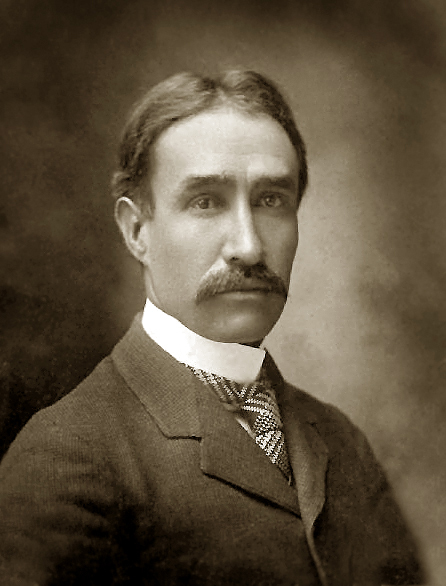Pioneer NMSU horticulturist to be named to national agricultural hall of fame

Fabián García, a Mexican immigrant whose research at New Mexico State University helped influence agriculture nationwide, will be inducted this fall into the National Agricultural Center’s Hall of Fame in Kansas, joining the ranks of Thomas Jefferson, George Washington and Eli Whitney, among other notable contributors to agriculture.
García is the first Hispanic member of the Hall of Fame and the first New Mexican to be inducted. The ceremony is scheduled to take place Oct. 8.
“Fabián García is a name more New Mexicans should know,” Gov. Michelle Lujan Grisham said. “The impact he made on agriculture in this state and beyond is a legacy that endures. He is every bit worthy of this honor, and my hope is New Mexicans both present and future will recognize his indelible contributions to our state.”
New Mexico Secretary of Agriculture Jeff Witte nominated García for the distinction.
“Fabián García’s induction into the National Agricultural Hall of Fame should make the entire state of New Mexico proud,” Witte said. “With his chile pepper research and development, he greatly influenced agriculture – not only in New Mexico – but in the entire country. As a Hall of Famer, he joins a list that includes Abraham Lincoln, Isaac Newton and John Deere, and he is very deserving of this recognition.”
García, who died in 1948, left behind no living relatives, but his legacy is still felt today. He was born in 1871 in Chihuahua, Mexico, and became an orphan early in his life. His grandmother moved with him to the Mimbres Valley when García was only 2 years old. Once there, García’s grandmother became a domestic worker, and she later found work with the Casad family in what is now known as Old Mesilla. The family provided García with a private tutor and later sent him to what was then known as Las Cruces College.
In 1894, García became a member of the first graduating class of New Mexico College of Agriculture and Mechanical Arts, now known as NMSU. He studied for another year at Cornell University but returned to Las Cruces to receive his additional degrees.
In 1907, García married Julieta Amador, a member of a prominent Mesilla Valley family. The couple had no surviving children, and Amador died in 1920. García never remarried, preferring the environment of his beloved university.
In 1914, García was named the first director of the state Agricultural Experiment Station as well as horticulturalist. His accomplishments include producing the first reliable chile pod, which was the beginnings of what is now the Sandia pepper popular among chile lovers. He also introduced the Grano onion breed, and was instrumental in planting some of the first pecan trees in the Mesilla Valley. Some of the 35 pecan tree varieties he helped plant still stand today.
García is also credited with developing modern irrigated agriculture in the state, and his horticulture publications included tests on pear, peach, grape and plum varieties, as well as trials of onion, spinach, melon and cauliflower varieties.
García’s reputation was that of someone who embraced tradition but did not resist change. He mixed humor with firmness, often joking to make a point and cajoling his researchers and others into agreement or compromise. He was financially astute, and had an impressive administrative reputation. Although at times he faced prejudice because of his Mexican heritage, he was also respected throughout the state because of his work.
“Fabián García was a dedicated NMSU educator, an innovator and a pioneer in the science and technology of agriculture,” said NMSU President John Floros. “His ideas in breeding and growing better plants that people would use for a more reliable, sustainable and tastier food supply, transformed agriculture in New Mexico, the country and the world. His passion for education changed numerous student lives, which in turn contributed hugely in making life better for everyone. His induction into the National Agricultural Hall of Fame is a testament to his legacy, and NMSU’s impact.”
Because of his background, García went out of his way to help poor Mexican-American students, often providing them rooms at the farm while they attended school. In his later years, he was known to say, “Don’t be ashamed to say you’re Mexican. I came from Mexico and I’m proud of it.” After his death in 1948, García left behind more than $85,000 to fund a campus dormitory and scholarships for poor youths with Spanish names, because, “I want to help poor boys, for I know their hardships.”
“The exemplary work of Fabián García in the farm fields of New Mexico and in NMSU’s life will live with NMSU and it is a wonderful role model to thousands of NMSU students of all ethnicities,” said NMSU College of Agricultural, Consumer and Environmental Sciences Dean Rolando Flores. “Fabián García, a unique hero of the College of ACES, is a testimony of the large number of Hispanic contributions to this great country.”
García was diagnosed with Parkinson’s disease, which left him bedridden and hospitalized in 1945, but he didn’t give up his love for agriculture and the university. He attempted to continue his directorship from his hospital bed, but university regents offered García the opportunity to retire.
His agricultural work made a such an impact, the university has named a 45-acre research station after him, as well as NMSU’s faculty-senate hall, its largest dormitory, and the building that houses the NMSU Center for Academic Advising and Student Support. He later received honorary doctorates from NMSU and the University of New Mexico.
“García devoted his life to agricultural science, and his work changed the face of New Mexico agriculture, and that of a nation,” said Paul Bosland, former Regents Professor of Horticulture, Distinguished Achievement Professor and Chile Pepper Institute Director.


